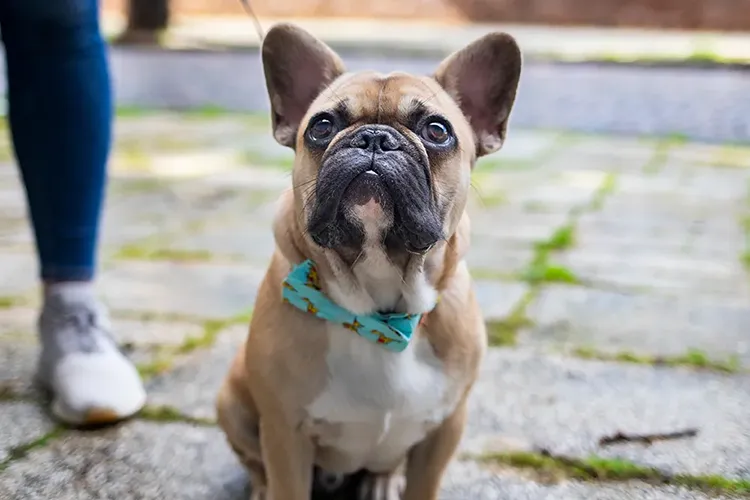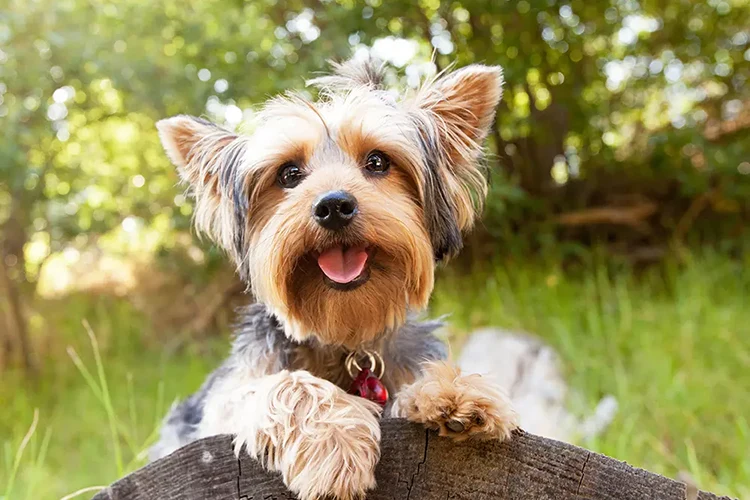Ready to help treat your pet to a healthy life?
A Guide to Small Dog Breeds
By : CJ Silvasi | Published Mar 27, 2025

Whether you live in an apartment, have a roommate, or prefer a dog that can curl up in your lap, there’s a lot to love about small dog breeds. Even if you’re among those who aren't sure about them, don’t let their size fool you — these dogs are a diverse bunch! From a workday lapdog to a buzzy socialite or an outdoor adventure buddy, these pocket-size pooches can fit into a wide variety of lifestyles.
Considering a tiny canine friend or just want to learn more about your own pet? Learn what it takes to be considered a small dog breed, get a look at popular small dog breeds, and discover insights on their unique health risks.
Defining a “small” dog breed
Size, even when it comes to dogs, is relative. For example, to a five-pound Chihuahua, a Beagle can be a giant. So, where is the line drawn for small dog breeds? Dog size is determined by the breed’s average weight:
- Small dogs: under 22 pounds (10 kg)
- Medium dogs: between 22 and 55 pounds (10-25 kg)
- Large dogs: over 55 pounds (25 kg)
Again, small dog breeds are varied and unique. Even within the smallest dog breeds, individual pups come in a wide range of sizes, temperaments, and personalities. If you’re limited on space or just prefer a more compact pet, exploring different kinds of small dogs is a great place to start.
What about teacup dogs?
Since we’re talking about the smallest dog breeds, you may be wondering about the tiniest canines of all — teacup dogs. “Teacup” is a term created to market ultra-small dogs that typically weigh less than five pounds. However, be aware that there is no naturally occurring teacup dog breed. These pets are types of designer dogs bred to be as small as possible. While these dogs tend to be downright adorable, this type of extreme size-focused breeding practice comes with a variety of potential health ramifications for both mother and pup. Many veterinary professionals recommend against going with a teacup dog as a result. Additionally, no kennel club currently recognizes any teacup as an established breed.
If you are interested in a small dog, look instead to one of the pets in the list below. You can also reach out to a reputable breeder and ask about the smallest dogs in their litters (being aware that any abnormally small dog may come with higher health risks).
10 of the smallest dog breeds
We love big dog breeds too, but great things come in small packages! Here are 10 popular small dog breeds — in no particular order — and what makes them great.
1. French Bulldog
Weight average: 8-10 pounds (4-5 kg)
Height average: 11-13 inches (27-33 cm)
Originating in England, the French Bulldog, or Frenchie, has a stocky build similar to one of its ancestors, the English Bulldog. The breed likely originated as a toy variety of the English Bulldog. Known for their expressive faces, bat-like ears, and affectionate personalities, it’s no wonder that Frenchies are one of America’s favorite dog breeds.
Frenchies are great family dogs and do well in smaller spaces like apartments. They are easily trainable and tend to easily adapt to different situations, so they can thrive in changing environments. These playful pups don’t have overly high energy levels, and unlike some other small dog breeds, they do not bark much.

2. Cavalier King Charles Spaniel
Weight average: 13-18 pounds (6-8 kg)
Height average: 12-13 inches (30-33 cm)
The Cavalier King Charles Spaniel (Cavalier or "Cav" for short) was such a favorite of King Charles II of England that he wrote a decree that they be permitted in all public spaces, including Parliament. Like other small dog breeds, Cavaliers were bred for companionship, and they love spending time with their human families. They excel in training and exercise activities that involve their humans.
Because they become so attached to the people around them, Cavaliers can suffer from separation anxiety. It is best to get your Cavalier comfortable with being alone while they are still young to avoid this. Alternatively, you can do what many other Cavalier pet parents do and adopt more than one so they always have a companion.
3. Pug
Weight average: 14-18 pounds (6-8 kg)
Height average: 10-13 inches (25-33 cm)
Pugs are full of charm and personality wrapped up in a compact package. Their dense core and short legs can make even the healthiest pug seem chunky. Because these sweethearts tend to be low energy and food motivated, be careful with rewarding Pugs too often during training — they can quickly become overweight. Daily walks and play sessions will help keep them at a healthy size, but be mindful of their breathing. Pugs’ flat noses can make breathing during exercise or in warm, humid environments difficult for them.
It’s also worth noting that Pugs are social dogs, doing well in public places if they are properly exposed to other pets and people from a young age. Their solid frame and playful nature make them a great match for families with children. Pugs can also suffer from separation anxiety though, so be sure to work with them while they are young so they are comfortable being alone.
4. Chihuahua
Weight average: 6-10 pounds (2-5 kg)
Height average: 6-9 inches (6-23 cm)
Chihuahuas are known for packing a lot of attitude in a small body. One of the tiniest dog breeds, Chihuahuas can be small enough to fit inside a purse, so you never know when one will pop up in public. Depictions of Chihuahua-like dogs have been found in Mexico dating back as far as 300 BC. They became one of the most popular dogs in Mexico, especially in the Chihuahua region from which their name stems. In the 1800s, American tourists brought them home with them, making them popular in the US too.
These small dynamos have a lot of energy, so they need regular exercise. Thanks to their small size, exercising your Chihuahua is as easy as a walk in the park, literally! However, because they are one of the smallest dog breeds, they can easily be injured by jumping or falling from high places, so investing in a ramp or stairs for furniture or cars is advised to keep them healthy.
5. Shih-Tzu
Weight average: 9-16 pounds (4-7 kg)
Height average: 8-11 inches (20-28 cm)
Shih-Tzus are a Tibetan dog breed known as the “Lion Dog”. Raised in monasteries, they were given as gifts to Chinese royalty. Art has been found depicting the Shih-Tzu dating back 2000 years. Shih-Tzus are affectionate and playful. That paired with their gentle nature makes them a great companion dog for families.
Their stunning long coats give them a regal grace and are more similar to human hair than traditional dog fur. They do require regular grooming and brushing to keep their coats from matting. Like other brachycephalic dogs, their flat noses can make breathing difficult in warm, humid environments.
6. Yorkshire Terrier
Weight average: 4-7 pounds (2-3 kg)
Height average: 6-7 inches (15-18 cm)
Yorkshire Terriers (Yorkies) are another one of the tiniest dog breeds. Hailing from the Yorkshire area of England, these petite pups were originally bred to hunt small rodents and vermin. The high prey drive and tenacious work ethic from their origins carries through in modern Yorkies. They are alert and full of personality, so they make tiny, but excellent watchdogs.
Yorkies tend to strongly bond with one person or a select few, and can become protective of their family, so early socialization is important. Like other terriers, they don’t realize how small they are, and their feisty personality shines from these small pups.
Yorkies have long, silky fur that requires regular maintenance to avoid matting. Their small size does make them susceptible to injury if they fall or jump from heights. So, it’s important to keep them from jumping off furniture or other tall items. Additionally, keeping these dogs at a healthy weight will help prevent unnecessary joint stress and weakening.

7. Pomeranian
Weight average: 3-7 pounds (1-3 kg)
Height average: 8-14 inches (20-36 cm)
Pomeranians are small, fluffy dogs with dynamic personalities. They love attention and are very intelligent, so they are easily trainable and love to entertain. These vocal pups make excellent guard dogs and will alert their owners to any upcoming visitors.
Pomeranians have a lot of energy in a small package, so regular play and exercise is an important part of their daily routine to avoid potential puppy behavior issues. Like the other small dog breeds on this list, their small stature means they are prone to injury from jumping off high places, so it’s important to take steps to keep them safe.
8. Toy Poodle
Weight average: 4-8 pounds (2-4 kg)
Height average: 9-11 inches (24-28 cm)
Poodles come in various sizes, so if you’re looking for a small dog breed, the Toy Poodle is for you. They are a smaller version of their larger sibling, the Standard Poodle, and have similar physical and personality traits. Their low-shed coat requires regular brushing and grooming, and while no dog is truly allergy-free, Poodles are often recommended for those looking for a hypoallergenic dog.
Poodles became so popular with the French aristocracy that it is the national dog. These regal dogs are clever and easy to train, so it’s no wonder they have become so popular in Europe and the US. They are eager to please and are great with people and families with small children if socialized and trained properly. Overall, Poodles tend to make excellent pets and service dogs alike.
9. Japanese Chin
Weight average: 4-15 pounds (4-7 kg)
Height average: 8-11 inches (20-28 cm)
Regal and distinguished, the Japanese Chin (or just "Chin") were bred to be companions to Japanese royalty and aristocracy. Chins were so highly regarded that it was actually illegal for anyone but the royal family to own them. As such, a Chin was considered one of the most valued gifts that could be given to visiting dignitaries.
Today Chins make great pets for people all over the world, of many different backgrounds. They are viewed as a cat-like breed in that they tend to be independent and aloof (early socialization is a must!). Chins are also popular for being low-maintenance and do very well in small environments.
10. Miniature Dachshund
Weight average: 8-11 pounds (3-5 kg)
Height average: 5-7 inches (13-18 cm)
Bred in Germany to help hunt rabbits, the Miniature Dachshund is the smaller version of the Standard Dachshund. They were bred to be this size in order to better assist with hunting animals like rabbits. Their skills as hunters were only matched by their love of people, making them excellent cuddle buddies today.
Intelligent, independent, and tenacious, Miniature Dachshunds are trainable, but pet parents must learn what motivates them. Regular exercise and play are important parts of avoiding potential boredom-based behavioral issues in these puppies.

Is a small dog the right pet for you?
The smallest dog breeds tend to make excellent companions — it’s what most of them were bred for, after all! But as discussed, small dogs are not a monolith. While some were designed to be low-key lap dogs, others were developed to burrow and hunt alongside humans. Getting to know each breed’s temperament and activity needs is a key part of finding the right dog for your family.
Training small dogs
Just like their larger counterparts, small dogs need to be properly trained and socialized from puppyhood. Small dog breeds can have a reputation for being difficult to train, but that is not always true. Many tiny dog breeds are underestimated because their smaller stature makes them less likely to be destructive, so they are not properly trained from puppyhood.
The biggest difference small-dog parents will notice is the method of training a small dog compared to a larger dog. Breeds like the Miniature Dachshund and Japanese Chin can be extra sensitive and do not respond well to yelling or negative behavior correction. Finding what motivates your dog is a sure-fire way to train them properly.
Health concerns
While smaller dogs tend to live longer than large dogs, that does not mean they are free of health concerns. The tiniest dog breeds are susceptible to injury when jumping or falling from your arms or the furniture. You can help prevent this by purchasing stairs or ramps to help them get up and down from their favorite spots, and lifting them in and out of cars.
Small dog breeds may also have genetic or chronic issues that come from the physical traits of the breed. For example, Miniature Dachshunds are prone to back problems thanks to their long shape. Likewise, some small dog breeds have flat faces, making them brachycephalic.
Working with a reputable breeder, regular veterinarian visits, and closely monitoring your dog are all crucial steps to take for their health. Even so, genetic diseases, injuries, and unexpected health issues can result in costly veterinary bills. Pet insurance is a good way to give you peace of mind about your budget by offering coverage for potential medical surprises experienced by small dog breeds.
Learn more about the benefits of pet health insurance today!
